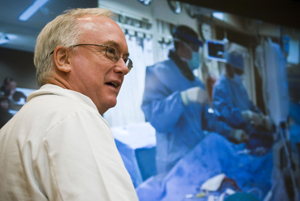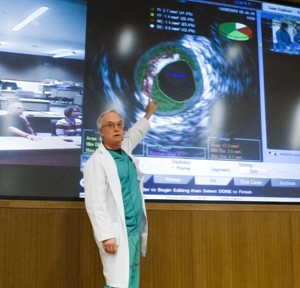 |
Ed O’Leary recently used Sorrell Center technology to teach health care professionals about some of the latest developments in catherterization. |
Oh yeah, and there’s usually a team performing a real catheterization in the room, too.
Recently, Dr. O’Leary lectured for the first time in a spacious, high-tech classroom in the Sorrell Center as he and participants watched a live video of a heart catheterization on a large screen.
“We’re taking advantage of the latest in technology for the first time in the Sorrell Center,” said Dr. O’Leary, a UNMC associate professor of cardiology. “I can lecture, the participants can ask questions and we can see everything better than if we were there in the cath lab.”
Participants saw clear images of the ‘cath’ lab team in action on one part of the screen and live computer images that showed healthy and plaque areas inside a patient’s heart artery.
During the class, nurses and cardiac laboratory technicians across the city brushed up on the Volcano Intravascular Ultrasound system (IVUS) used in cardiac catheterizations.
The video was streamed through videoconferencing technology from The Nebraska Medical Center’s catheterization lab, while Keith Weeks, M.D., cardiologist, and other team members performed the procedure on a patient. Specialists in the lab worked together with UNMC ITS Video Services to link the broadcast to the Sorrell Center.
 |
Ed O’Leary, M.D., talks about plaque found in the patient’s artery shown through the Volcano Intravascular Ultrasound system monitor. |
Class participant Brad Davis, an X-ray cardiovascular technician, said he learned more about the functions of the IVUS system, which were seen clearly and prominently on the large screen.
Jorge Parodi, executive director of the cardiovascular and pulmonary service lines at The Nebraska Medical Center, said the medical center decided two years ago to expand training capabilities.
“We worked very long to get this done,” Parodi said. “I think it’s a great way to get more people into the hospital and showcase our technical abilities in the Sorrell Center.”